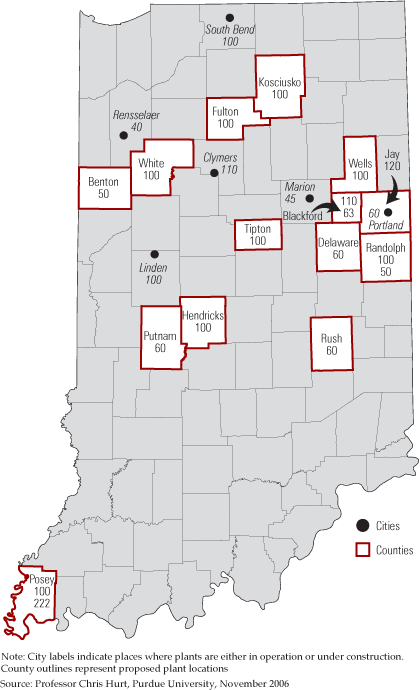Indiana Agriculture
Department of Agricultural Economics, Purdue University, West Lafayette
Indiana agriculture is undergoing a massive transition and entering the energy business. Going forward, this leap into farming for fuel means that the price of gasoline will have a large impact on Indiana farm incomes and farmland values.
Ethanol produced from corn is leading the way. Right now, there is an existing ethanol plant in South Bend, with an additional four plants at Rensselaer, Marion, Clymers, and Linden that will be on-line in 2007. These four new ethanol plants will utilize about 160 million bushels of corn, equivalent to 12 percent of Indiana’s 2006 corn production. The State of Indiana is working with an additional eight plants located in Blackford, Jay, Putnam, Posey, Tipton, Randolph, and Rush counties. The Purdue list indicates at least another ten groups considering plant sites. If all of the proposed plants are built, the demand for corn for these plants will be the equivalent of 81 percent of Indiana’s 2006 corn production. Even if only a fraction of these plants are build, this new usage for corn will dramatically alter Indiana’s agriculture (see Figure 1).
Figure 1
Ethanol Plant Locations and Plant Size in Millions of Gallons of Ethanol per Year

Biodiesel produced from soybean oil is not developing as quickly as ethanol. The largest facility will be a new soybean crushing facility being built at Claypool in Kosciusko County by Louis Dreyfus, Inc. That plant will process 50 million bushels of soybeans per year, equivalent to 17 percent of Indiana’s 2006 soybean production.
Why has interest in biofuels approached “gold rush” status in the last year? With crude oil prices above $50 a barrel, biofuels, and ethanol in particular, have become extremely profitable. As recently as 2004, crude oil was well below $40 a barrel, a point where biofuels are not profitable. In 2006, with crude oil in the $60 to $70 a barrel range, the outlook for the ethanol market is rosy. However, profitability in the ethanol market is vulnerable to the price of crude oil.
Farm Income and Farmland Values
How will the development of ethanol and biodiesel plants in Indiana affect farm incomes and farmland values? The answer for farm incomes depends on the enterprise, with grain operations benefiting from the biofuels boom and livestock operations who must buy grain to feed their animals struggling. To highlight this point, between October 12, 2006 (when World Agricultural Supply and Demand Estimates were released), and November 3, 2006, the December 2006 corn futures price had increased about 67 cents from $2.77 to $3.44 because U.S. corn production was revised downward. This large increase in the price of corn will translate into an additional $112 per acre of income for the projected 2006 state average corn yield of 167 bushels per acre. However, Dr. Chris Hurt estimates that the typical Indiana hog operation will not be profitable if the price of corn (the primary cost for hog operations) is above $3.50. For Indiana hog producers, this 67 cent increase in the price of corn means that the profitability in their operations is quickly disappearing.
Farmland value depends on many factors, including long-term interest rates, government price support payments, real estate taxes, and most importantly, on the returns to crop production. Looking to 2007, the biofuels boom can be expected to increase the value of farmland with its large impact on the returns to crop production. Given the current price levels for corn and soybeans, prices are well above the level where government price support payments would be triggered, reducing the influence of government programs. Long-term interest rates can be expected to increase, which would put downward pressure on land prices, but this increase is happening slowly. Overall, the biofuels boom will increase the value of Indiana farmland for 2007 and beyond.
Notes
- For more information about Indiana farmland values, see the Purdue Land Value Survey at: www.agecon.purdue.edu/extension/pubs/paer/2006/august/paer0806.pdf.
- More information about the Indiana agricultural outlook can be found at: www.agecon.purdue.edu/extension/pubs/paer/2006/october/paer1006.pdf.
Also in this Issue…
- Outlook for 2007
- The International Economy
- The U.S. Economy
- Financial Forecast
- Housing
- Indiana Agriculture
- Indiana
- Anderson and Muncie
- Bloomington
- Columbus
- Evansville
- Fort Wayne
- Gary
- Indianapolis
- Kokomo
- New Albany
- Richmond
- South Bend and Elkhart-Goshen
- Terre Haute
- Indiana Metro Economies at a Glance
- Return to Table of Contents



